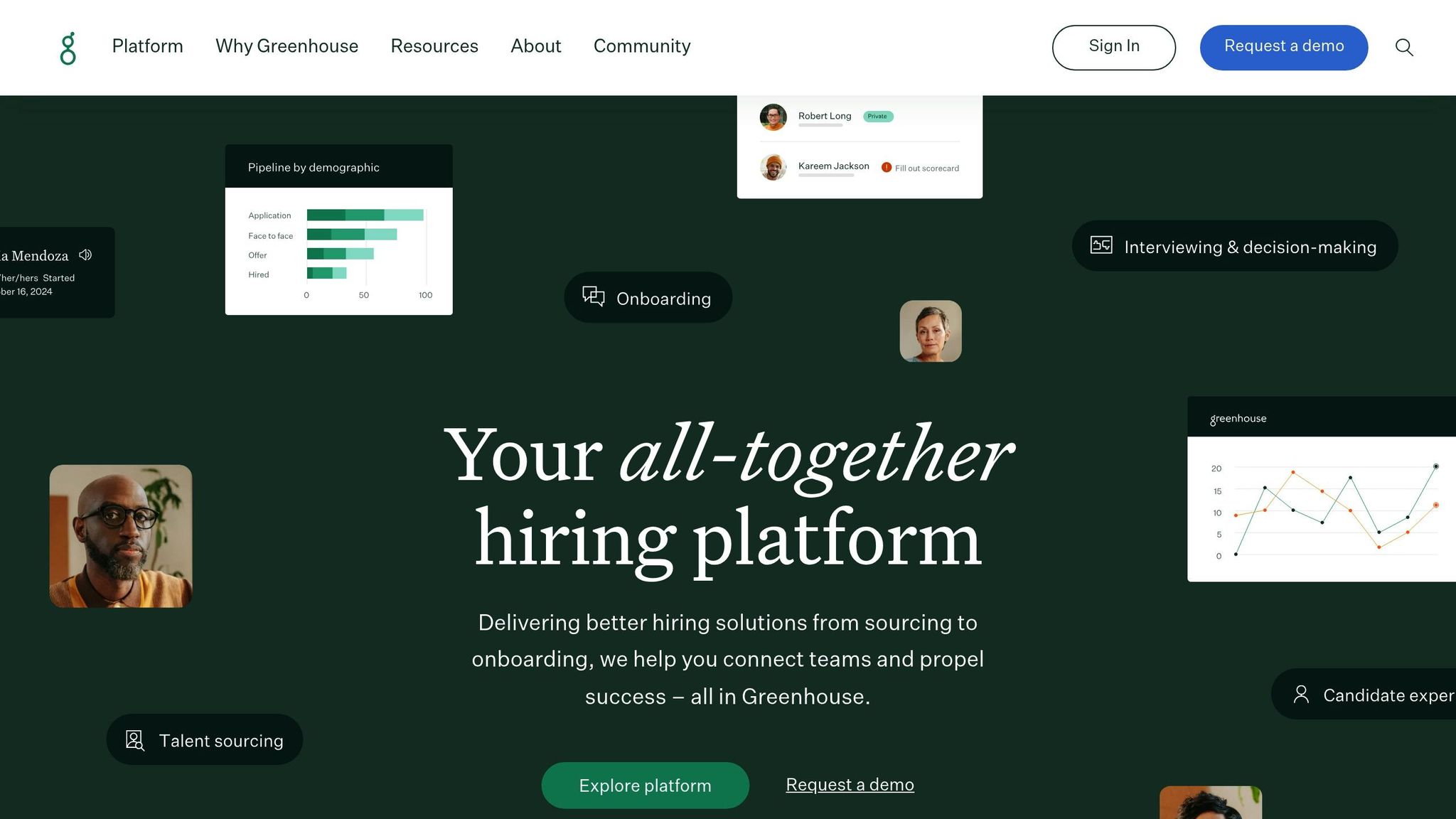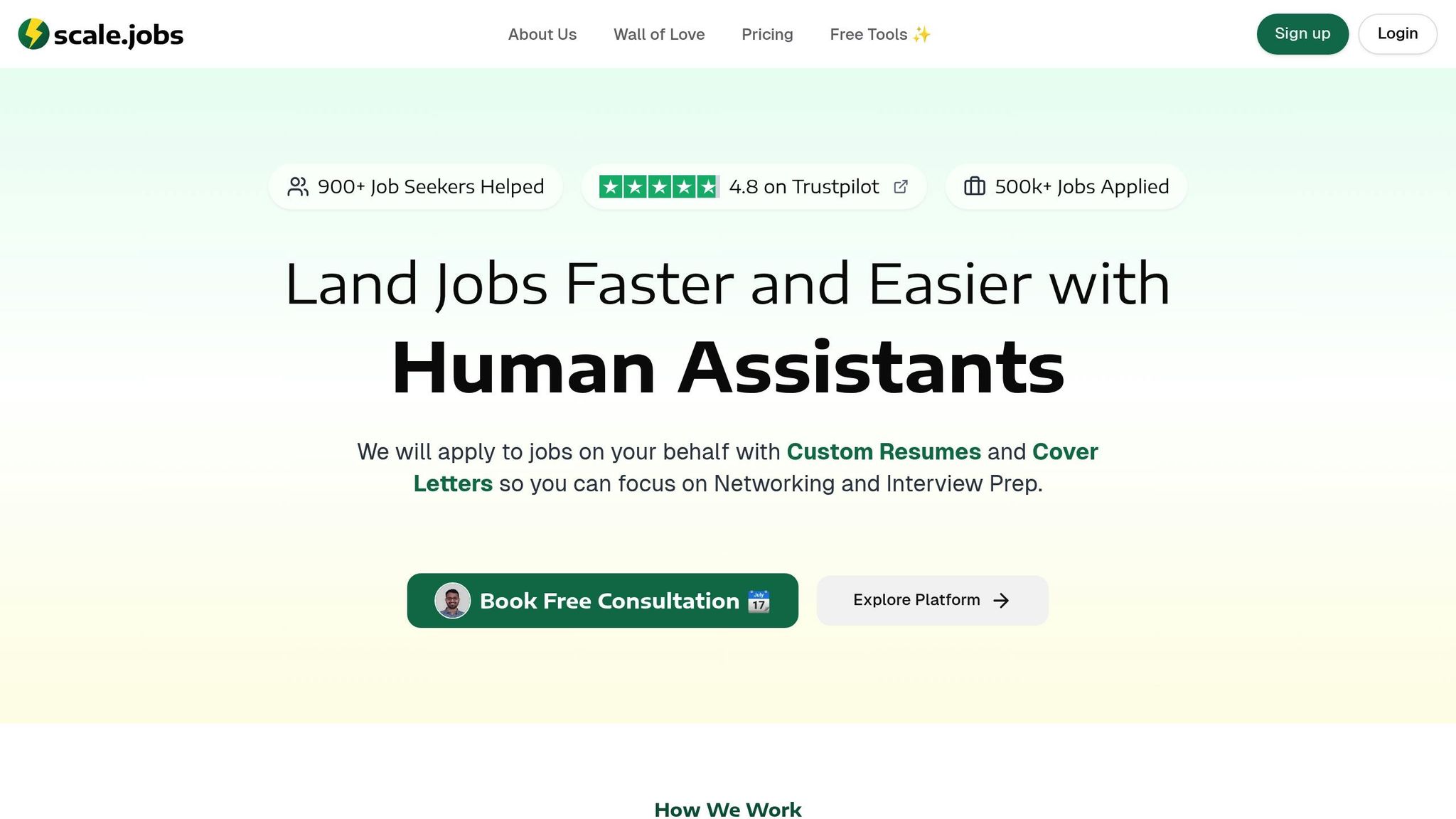How To Measure Candidate Experience Effectively
Learn how to effectively measure candidate experience to enhance hiring processes, boost employer branding, and attract top talent.

Candidate experience matters because it affects hiring costs, time-to-fill, employer reputation, and your ability to attract top talent.
To measure and improve candidate experience, focus on these steps:
- Key Metrics: Track Net Promoter Score (NPS), application completion rates, interview satisfaction, and response times.
- Feedback Collection: Use short surveys after key hiring stages (application, interview, rejection) with a mix of ratings and open-ended questions.
- Hiring Process Breakdown: Evaluate each phase - application, interviews, offers, pre-boarding, and onboarding - for clarity, communication, and efficiency.
- Actionable Changes: Simplify applications, provide timely updates, and train recruiters in delivering clear and constructive feedback.
- Tools: Leverage ATS features like automated surveys and feedback analysis tools to streamline data collection and improvement efforts.
Why it’s important: A smooth, respectful candidate experience leads to higher offer acceptance rates, better employer branding, and a stronger talent pipeline. Start by gathering feedback and making small but impactful changes.
What Makes Good Candidate Experience
Definition and Scope
Candidate experience includes every interaction a job seeker has with your company, from discovering the job to the final hiring decision. A strong candidate experience involves:
- Clear communication: Providing accurate and detailed job descriptions
- Simplified processes: Offering easy-to-navigate application systems
- Timely updates: Keeping candidates informed at every stage
- Professional interactions: Ensuring interviews are respectful and well-organized
- Constructive feedback: Sharing useful insights with all candidates, regardless of the outcome
Importantly, the experience doesn't end with the hiring decision. Even candidates who aren't selected should feel respected and valued. These factors not only define the candidate experience but also play a role in shaping key business outcomes.
Business Impact
A poor candidate experience can have serious consequences for your business. It can lead to:
- Higher hiring costs: Longer time-to-fill positions drive up expenses
- Weaker talent pipeline: Fewer high-quality candidates are attracted to your roles
- Damaged brand reputation: Negative experiences can reduce future application rates
Tracking these impacts using specific metrics and gathering feedback is crucial. This data helps organizations pinpoint problem areas and refine their hiring processes to attract and retain top talent more effectively.
Steps in the Hiring Process
Main Hiring Phases
To effectively measure candidate experience, it's important to understand the key stages of the hiring process. Each step offers a chance to evaluate interactions and gather feedback:
Application Phase
- Job discovery and application submission
- Resume and cover letter submission
- Confirmation of application receipt
- Pre-screening assessments or tests
Interview Process
- Initial phone or screening calls
- Technical evaluations or assignments
- Virtual or in-person interviews
- Meeting with team members
Decision and Offer Stage
- Conducting reference checks
- Offer discussions and negotiations
- Reviewing and signing contracts
- Background checks
Pre-boarding
- Collecting necessary documentation
- Setting up system access
- Introducing the new hire to the team
- Coordinating start dates
Onboarding
- Orientation on the first day
- Establishing a training schedule
- Providing necessary equipment
- Setting initial performance goals
Key Feedback Points
Gathering feedback at crucial moments in each phase can highlight areas for improvement:
Application Stage Feedback
- Clarity of job descriptions
- Ease of using the application system
- Time required to complete the application
- Quality of communication during this phase
Interview Process Feedback
- Flexibility and convenience of scheduling
- Preparation and professionalism of interviewers
- Relevance of questions asked
- Fairness of assessments
Post-Decision Feedback
- Time taken to communicate decisions
- Quality and clarity of feedback provided
- Professional tone of communication
- Explanation of next steps
Pre-boarding Experience
- Simplicity of the document submission process
- Speed of responses to questions
- Clear and detailed instructions
- Availability of support when needed
Using both numerical ratings and open-ended responses to measure these feedback points ensures a well-rounded understanding of the candidate experience. Regularly reviewing this data helps maintain high standards and improve the hiring process.
Measure candidate experience with Greenhouse x Trustcruit ...

Getting Candidate Feedback
Collecting accurate feedback during every stage of the hiring process is crucial for addressing the issues mentioned earlier.
Survey Design
Craft candidate surveys to focus on key hiring moments and gather actionable insights.
Here’s what makes a strong candidate survey:
- Response Scale: Stick to a consistent 5-point Likert scale for easy-to-analyze quantitative data.
- Timing: Send surveys within 24–48 hours of key interactions to keep feedback fresh.
- Length: Keep it short - 5 to 7 minutes is ideal.
- Question Mix: Combine rating scales with open-ended questions for a balanced view.
- Mobile Optimization: Ensure surveys are easy to complete on mobile devices.
A suggested survey structure might look like this:
| Question Type | Purpose | Example Question |
|---|---|---|
| Process Rating | Measure satisfaction | "How would you rate the clarity of our application process?" |
| Time Assessment | Evaluate efficiency | "How long did it take to complete the application?" |
| Communication | Assess responsiveness | "Rate the timeliness of our communication." |
| Open Feedback | Gather detailed suggestions | "What could we improve about our interview process?" |
Once you’ve set up your surveys, focus on gathering insights after decision points to fine-tune the hiring experience.
Feedback After Rejection
Ask rejected candidates for feedback 48–72 hours after notifying them. This timing allows emotions to settle, leading to clearer and more constructive responses.
Key elements of effective post-rejection feedback:
- Start by acknowledging their time and effort.
- Show genuine interest in their perspective.
- Keep a professional and respectful tone.
- Ask clear, specific questions about their experience.
- Keep the survey concise and focused.
Interview Experience Surveys
Building on earlier survey techniques, tailor feedback specifically for the interview stage to gain deeper insights. Use separate surveys for virtual and in-person interviews to address format-specific concerns, and send them within 24 hours of the interview.
What to Focus On:
- Preparation and Organization: Evaluate pre-interview communication, scheduling, clarity of expectations, and technical setup for virtual interviews.
- Interview Quality: Assess interviewer preparedness, relevance of questions, time management, and the overall interview environment.
- Follow-up Process: Gather feedback on the timeliness of responses, clarity of next steps, communication quality, and overall professionalism.
These focused surveys can help pinpoint areas for improvement and enhance the overall candidate experience.
Making Sense of Feedback Data
Numbers and Metrics
Turn candidate feedback into useful insights by focusing on these key performance indicators:
Important Metrics to Monitor:
| Metric | Target Range | What It Reveals |
|---|---|---|
| Net Promoter Score (NPS) | 30-50 | Candidate satisfaction levels |
| Survey Response Rate | 40-60% | Effectiveness of your feedback program |
| Time-to-Feedback | < 48 hours | How quickly you communicate |
| Application Completion Rate | > 85% | Areas causing friction in the process |
| Interview Show Rate | > 90% | Candidate engagement and interest |
Review these metrics on a monthly and quarterly basis to spot trends early. Use automated dashboards to keep track of changes and address any declines promptly.
How to Segment Data:
- Break down metrics by department and role.
- Compare scores from virtual and in-person interviews.
- Analyze feedback from different hiring stages.
- Separate metrics for internal vs. external candidates.
Pair these numbers with qualitative insights for a more complete understanding.
Written Feedback Review
Qualitative feedback gives context to the numbers and highlights areas for improvement.
Steps for Reviewing Text Feedback:
- Group comments into themes like communication, process clarity, or interviewer preparedness.
- Look for recurring issues or praise to identify patterns.
- Use a priority matrix to decide on improvements based on effort and impact:
| Impact | Low Effort | High Effort |
|---|---|---|
| High Impact | Quick fixes (e.g., improving email templates) | Larger projects (e.g., upgrading your ATS) |
| Low Impact | Nice-to-haves (e.g., better office directions) | Long-term ideas (e.g., branded swag) |
Tips for Sentiment Analysis:
- Use tools to determine the emotional tone of comments.
- Track the ratio of positive to negative feedback.
- Highlight urgent concerns immediately.
- Document examples of both good and bad experiences for reference.
Acting on Feedback Results
Fixing Process Problems
Use candidate feedback to refine and improve your hiring process. By identifying and addressing common pain points, you can create a smoother, more appealing application experience.
Key Areas to Address:
| Pain Point | Solution | Benefit |
|---|---|---|
| Long application forms | Reduce form fields to only the essentials | Fewer drop-offs during applications |
| Unclear job descriptions | Use clear templates with defined criteria | More appealing and understandable job postings |
| Delayed responses | Automate updates for application status | Less candidate uncertainty and fewer inquiries |
| Complex technical tests | Break assessments into smaller sections | Better completion rates and engagement |
Recruiter Training
Equip your hiring team with the skills needed to improve the candidate experience. Focus training efforts on areas highlighted by feedback:
- Interview Skills: Teach structured interview techniques and raise awareness about unconscious bias.
- Communication Guidelines: Set clear standards for timely responses and maintaining a professional tone in messages.
- Feedback Delivery: Train recruiters to provide constructive feedback, whether candidates are moving forward or not.
Regular training sessions ensure your team stays updated on effective practices. Once implemented, these skills can help recruiters communicate more clearly and close the feedback loop with candidates.
Candidate Communication
After making internal improvements, proactive communication plays a critical role in addressing candidate concerns. By combining process enhancements with recruiter training, you can ensure candidates feel informed and valued throughout the hiring journey.
How to Communicate Effectively:
- Send confirmation emails immediately after receiving applications.
- Provide feedback after interviews, regardless of the outcome.
- Share regular updates and confirmations to keep candidates in the loop.
Example of a Status Update Email:
"Thank you for your patience during our hiring process. Based on candidate feedback, we’ve made updates to simplify our technical assessments. You’ll receive detailed information about the updated process shortly."
This approach not only keeps candidates informed but also demonstrates that their feedback is taken seriously.
Tools for Measuring Candidate Experience
ATS Features
Modern applicant tracking systems (ATS) include tools that simplify the process of measuring candidate experience. These systems combine feedback methods into a single platform, making it easier to evaluate and improve the hiring process.
Key ATS Features for Candidate Experience:
| Feature | Purpose | Implementation |
|---|---|---|
| Automated Surveys | Send surveys at critical stages | After application, interviews, and decisions |
| Response Analytics | Measure candidate engagement | Track open rates, response times, and completions |
| Status Tracking | Keep candidates informed on application progress | Automate status updates |
| Communication Logs | Record all candidate interactions | Track response times and communication quality |
In addition to ATS tools, using specialized feedback platforms can provide even deeper insights.
Feedback Analysis Tools
Feedback analysis software transforms candidate feedback into meaningful data that you can act on. These tools help you identify patterns, trends, and areas for improvement.
Core Features of Feedback Tools:
- Sentiment Analysis: Detect positive and negative trends in written feedback.
- Response Categorization: Organize feedback into themes for easier review.
- Trend Identification: Track changes in candidate satisfaction over time.
- Custom Report Generation: Build reports tailored to specific hiring phases.
When choosing feedback tools, look for options with real-time dashboards and flexible reporting features. These help you address issues quickly and efficiently.
Tracking Metrics
To improve candidate experience, it’s crucial to track measurable data. Focus on these performance indicators to guide your efforts:
Key Metrics to Watch:
| Metric | Target Range | Review Frequency |
|---|---|---|
| Application Completion Rate | 75-85% | Weekly |
| Time-to-Response | Under 48 hours | Daily |
| Interview Satisfaction Score | Above 4.2/5.0 | Per Interview |
| Offer Acceptance Rate | Above 85% | Monthly |
| Net Promoter Score (NPS) | Above 40 | Quarterly |
Automating the tracking process ensures consistency. Review daily for immediate insights, analyze weekly trends, and assess broader performance on a monthly or quarterly basis.
Long-term Success Tips
Keeping candidate satisfaction high over time requires a commitment to ongoing improvement. These strategies build on earlier steps by integrating regular feedback into your hiring approach.
Clear Communication
Transparent communication is essential for long-term success. Here are some ways to make it happen:
- Respond to inquiries quickly
- Share regular updates on application status
- Provide multiple ways for candidates to share feedback
- Clearly outline timelines for each stage of the process
You can use automated notifications with a friendly tone to keep candidates informed without overwhelming your team.
Individual Attention
Personalized interactions leave a lasting impression on candidates. Focus on:
- Scheduling interviews that consider candidates' time zones
- Delivering detailed feedback as soon as possible
- Assigning a specific contact person for each candidate
- Tailoring communication to fit the role and candidate
Track these personalized efforts in your ATS to measure how they affect satisfaction.
Regular Updates
Consistently reviewing feedback helps you fine-tune your process over time.
Monthly Reviews
- Look for patterns in recent feedback
- Adjust survey questions and automated messages as needed
- Update the metrics you use to measure success
Quarterly Assessments
- Compare satisfaction scores across different teams
- Examine long-term trends in feedback
- Set new benchmarks based on findings
- Improve tools and processes
- Provide recruiters with updated training on best practices
Scale.jobs Features

Scale.jobs simplifies the job application process with tools and services designed to improve the candidate experience.
Application Support
Scale.jobs offers tools to help you manage your job applications more effectively:
- Resume ATS Checker: Ensures your resume is optimized for applicant tracking systems.
- Job Applications Tracker: Keeps tabs on your application statuses and response rates.
- Cover Letter Generator: Creates customized cover letters tailored to specific job requirements.
- Portfolio Website Generator: Helps you build a professional online presence.
These tools provide actionable data to track your progress and pinpoint areas for improvement. The automation lays the groundwork for more personalized assistance.
Virtual Assistant Help
Scale.jobs also offers virtual assistants who handle applications on your behalf. They work quickly, submitting applications with custom resumes and cover letters within 12–24 hours.
"We will apply to jobs on your behalf with Custom Resumes and Cover Letters so you can focus on Networking and Interview Prep."
With this service, 93% of users land full-time roles within three months. The platform combines tailored support with affordable pricing to deliver results.
Cost-effective Options
Starting at just $4 per hour, Scale.jobs provides budget-friendly support:
| Service Level | Features | Typical Outcomes |
|---|---|---|
| Standard Support | Basic application help and custom documents | Cuts job search time by about 40%. |
| Premium Support | Dedicated assistant and personalized strategies | Fast results - 70% of users secure jobs within 30 days. |
Users consistently praise the service. For instance, Apoorv Singh, a consultant dealing with visa challenges, landed three job offers in four weeks and saw a 75% salary increase using the premium service.
"Scale.jobs has been an excellent help in applying for high volume of jobs which otherwise would be very time consuming... This is extremely useful in the current job market as a high-volume approach helped me get few interview calls which I wasn't getting earlier." – Shobhit Datta
With an impressive 200× ROI, Scale.jobs makes job applications faster and more effective, helping candidates achieve their career goals.
Summary
A quick look at measuring candidate experience highlights its importance. Companies that focus on improving candidate experience often enjoy benefits like higher offer acceptance rates and a stronger reputation as an employer.
Here are some key metrics to track candidate experience:
| Metric Type | What to Measure | Why It Matters |
|---|---|---|
| Response Time | Average time to respond to applications | Shows respect for candidates' time |
| Interview Feedback | Satisfaction scores from post-interview surveys | Helps identify areas for improvement |
| Communication Quality | Frequency and clarity of updates | Builds trust with candidates |
| Process Efficiency | Time from application to offer or rejection | Reflects the overall experience |
These metrics not only provide insights into candidate experience but also help platforms like Scale.jobs enhance the hiring process. Scale.jobs simplifies applications, allowing candidates to focus on preparing for interviews and building connections. Impressively, 93% of Scale.jobs users have landed full-time roles within three months. By automating repetitive tasks, the platform ensures candidates can concentrate on what truly matters.
To succeed in improving candidate experience, consistent feedback and quick action are key. Keep communication open and provide regular updates to turn feedback into meaningful changes. Ultimately, a great candidate experience is about fostering genuine, respectful interactions between employers and candidates.




